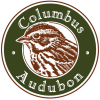Some of Columbus’ neighborhoods offer surprisingly good birding, usually depending on how much of their native forest is still there. One of the most interesting, both biologically and historically, is Minerva Park. As its name implies, this was once a park, but it was an amusement park rather than a nature park. The park kept a cover of mature oak trees for shade and ambience, many of which still dot the neighborhood. The amusement park sat along a trolley line from Columbus to Westerville, and dammed a small ravine to make a pond that still exits today. The amusements closed down in 1902, and the land went through a succession of uses before ending as a housing development in the 1950s. The developers left many of the large trees and the ravine (which runs through the backyards of some of the residences), and committed the eastern, open end of the grounds to a golf course. The result is a semi-natural setting where many of the houses sit among large trees. This, along with the adjoining greenspace of the Golf Course and nearby Walthall Woods ravine, make for a green island that can be quite attractive to birds in almost any season.
During the recent heavy snows, I hiked around this neighborhood, both because I knew it would be plowed and because I wanted to see if it accumulated any unusual winter wanderers. I parked on Minerva Park Drive along the edge of Minerva Park Lake, just east of the Community center. The lake is fringed by large European alders, a favorite foodplant of Pine siskins, and they have been seen here often in the past. This wasn’t an invasion year, however, so I could find none of the little finches despite a careful search. If you hike around the eastern end of the Lake, a footpath takes you over the dam to Lakewood Drive on the south side. The small ravine below the dam and the west edge of the Golf Course here is good for birds, and I had small groups of chickadees, titmice, nuthathces, Robins, and sparrows today, despite the deep snow. These concentrations of birds can attract the resident Cooper’s Hawks, but not today. I’ve also had Red-tails, and even a perched Merlin on one occasion, since the interface between the yards and the golf course must offer them a good edge to hunt.

Hiking west along Lakewood or Alder Vista roads takes you through some tree-lined streets that often have woodpeckers and other tree birds. Today, Cardinals, Downies, and even a Hairy Woodpecker graced the yards, along with the expected chickadees, titmice,and goldfinches. At the Cleveland Avenue entrance to the Park, I walked north a half block to Minerva Park Drive, then headed east back into the northern half of the neighborhood. Here were yards with large old oaks; in fact, this area is a great place to see lots of cicadas during their hatch years, a sign that the trees are old and in stable health. Several Downies chased each other through the large trees, and lots of chickadees and titmice hung close to the houses with their feeders. A few White-throated sparrows whistled forlornly from the bushes, inconvenienced by the deep snow. Further along, I watched a Cooper’s hawk launch from one of the treetops and leisurely flap north into the neighborhood. A pair has nested in the vicinity for many years, sometimes in the Golf Course, others times in the neighborhood. A large bulky stick nest in a tree along Minerva Park Drive looked suggestive, but I’ll have to come back in March to see if it’s in use.
I finished back at the Community center and the pond. The pond was frozen over today, but when it’s open it often has rafts of Canada Geese and mallards, along with the occasional Wood Duck or Hooded Mergansers. The ravine, pond and oaks in Minerva Park have been attracting birds for a long time. Long-time Audubon leader Ernie Limes used to make his home here, and recorded a great variety of birds from the vicinity. Alas, since he passed away in 2002, the area had not been visited much. In part it was because of some of his anecdotes that I started paying attention to Minerva Park. This will be the 6th year that I’ve hiked around here in winter and Spring; I can hardly wait for the snow to recede and see what shows up in this bird oasis.

